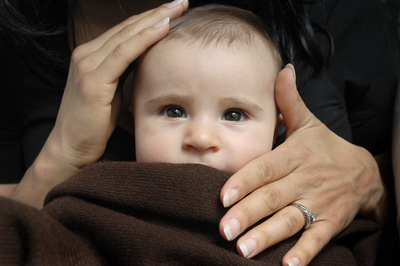 This is a story about a simple picture gone wrong and why a do-over is sometimes the right thing to do.
This is a story about a simple picture gone wrong and why a do-over is sometimes the right thing to do.
Every month in Marin Magazine I do a small feature called Marin Album — a photograph and a short essay. Typically, the photo is some scenic slice of Marin life, like this one of a cyclist in the Headlands or this one of a little leaguers on opening day of baseball season.
For the May issue, the magazine asked if I could make a picture for Mother’s Day of a mom and her new child. Nice, I thought, that will be sweet. Plus, it’s simple. I can use window light and skip some of the complicated setups I’d been doing recently.
One of the magazine’s writers had a baby a month ago, a boy, so I arranged a visit to her home. When she opened the door, her dog, some kind of pug, started barking and never stopped — I kid you not — for the hour I was there. It was a sign I should have heeded.
I looked around the house. Too dark to shoot in except for the living room. But the windows were behind the sofa, meaning if I put her and the baby on the couch their faces would be in shadow.
This is where the “should have”s” begin — I should have brought in some lights instead of sticking with the natural light plan. I should have asked her to change her green shirt, which reflected an icky tone on the baby’s skin. I should have taped the dog’s mouth shut.
And, when she brought out her son from his crib I should have said, “This is not going to work.” He was a cute kid, as all month-old’s are, but his skin was bright red, blotchy and pimply. a condition I later learned to be “baby acne.” Without some serious Photoshop retouching, this little boy was going to look more like pre-pubescent teen than Baby of the Month. (And, don’t forget mom’s green shirt adding to color mix.)
I should have said I’d be back in a month, but I didn’t. I shot, I used reflectors, I turned them this way and that. Two gigs later, nada.
 Later, looking at the shoot in the computer, I kept thinking, “How could I blow a shot of a baby.” All I wanted was this and the best I got is what you see to the left.
Later, looking at the shoot in the computer, I kept thinking, “How could I blow a shot of a baby.” All I wanted was this and the best I got is what you see to the left.
I fessed up to the magazine, blamed the dog and said I needed another mom and another baby. That’s how I met 3-month-old Maya, above, and her mother, Ines. This time I told them what to where, brought in some lights and put the dog outside. Better. Much better. And at the point when I wrapped Maya in the blanket and asked Ines to hold her head I knew I had the shot I wanted.
Ines’ hands wrapped around Maya’s tiny head reminded me of what my mother used to say about her hands, how as she grew older they resembled those of her mother.
I used that thought as the key for the text below (after the jump).
———————————————————————————-
The Hands of My Mother
“All women become like their mothers. That is their tragedy. No man does.” — Oscar Wilde
My mother, Eleanor, is 81 and sometimes in the early evening she sits at the dining rooming table, a cup of tea steeping nearby, and pauses in the middle of a conversation to look at her hands.
